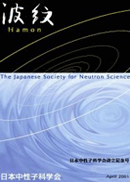
- Issue 4 Pages 154-
- Issue 3 Pages 114-
- Issue 2 Pages 66-
- Issue 1 Pages 2-
- |<
- <
- 1
- >
- >|
-
- A New-type Experiment with J-PARC Pulsed BeamKenji Mishima, Go Ichikawa2022Volume 32Issue 3 Pages 114-119
Published: August 10, 2022
Released on J-STAGE: December 01, 2023
JOURNAL FREE ACCESSA neutron decays into a proton, an electron, and an antineutrino through the weak interaction. The recent measurements were performed by two different experimental methods. One is a so-called bottle method; the number of the surviving ultra-cold neutrons (UCNs) contained in a storage bottle is measured as a function of the elapsed time, and the lifetime is determined with an exponential decay curve. On the other hand, the beam method determines the neutron lifetime from the decay probability of the neutron obtained from the measured ratio of the decay rate to the incident neutron flux. The averaged neutron lifetimes with the two methods differ by 9.5 s, corresponding to the deviation of 4.6σ using quoted uncertainties. The discrepancy is called the “neutron lifetime puzzle”, and it is still unsettled whether it is due to any unconsidered systematic effect or any new physics. To solve the neutron lifetime puzzle, a new-type of experiment is conducted with pulsed neutron beam at J-PARC MLF.
View full abstractDownload PDF (1771K) -
Kazuhiro Akutsu, Takayasu Hanashima, Hiroshi Kira, Tomotake Niizeki2022Volume 32Issue 3 Pages 120-123
Published: August 10, 2022
Released on J-STAGE: December 01, 2023
JOURNAL FREE ACCESSWe have introduced polarized neutron reflectivity (PNR) techniques, polarization analysis and magnetic contrast variation neutron reflectivity (MCV-NR), for structural analysis of soft material samples. We performed polarization analysis on an Si/SiO2/polypropylene (PP) sample and MCV-NR analysis on a deuterated polystyrene (PS-d)/Fe3O4 sample to investigate their fine structures. Fitting analysis results of the NR data with polarization analysis indicated that the bulk PP plate penetrated into the SiO2 layer due to the sandwiching of the silicon-substrate and PP. On the other hand, the MCV-NR analysis reveals the surface roughness value of the PS-d/Fe3O4 sample to be 2.2 Å. The structural analysis using the NR with the polarization analysis and MCV-NR enables the investigation of fine structures of soft material samples, and the results lead to a better understanding of the nano-layers and surface structures of soft materials.
View full abstractDownload PDF (709K) -
-Structure Analysis of Catalyst Layers by Small-angle Scattering-Masashi Harada2022Volume 32Issue 3 Pages 124-127
Published: August 10, 2022
Released on J-STAGE: December 01, 2023
JOURNAL FREE ACCESSDevelopment of polymer electrolyte fuel cells (PEFCs) is required to realize hydrogen economy. Contrast-variation small-angle neutron scattering was measured for a catalyst layer of PEFCs to analyze the ionomer distribution on the carbon aggregates. The depth-profile of an ionomer thin film in a catalyst layer was investigated by neutron reflectometry and the water dynamics in a catalyst layer was evaluated using quasi-elastic neutron scattering. Neutron radiography was applied to distinguish frozen ice from fluid water. By using various neutron techniques, we can approach to what we could not observe in PEFCs so far.
View full abstractDownload PDF (992K) -
Akihisa Yamamoto2022Volume 32Issue 3 Pages 128-132
Published: August 10, 2022
Released on J-STAGE: December 01, 2023
JOURNAL FREE ACCESSThe structures of “apparently hydrophobic” poly(perfluorooctyl acrylate) films composed of acrylate polymers with pendant-like perfluorocarbon side chains connected by different linkers were investigated using off-specular neutron scattering experiments at defined osmotic pressure. The poly[(perfluorooctyl)ethyl] acrylate (PFA-C8) showed almost identical lamellar periodicity independent of the osmotic pressure, suggesting that PFA-C8 was poorly hydrated. The poly{2-[(perfluorooctylethyl) carbamate]ethyl} acrylate (PFAUr-C8) showed the slight increase of the lamellar periodicity with decreasing osmotic pressure, while the vertical correlation length increased. These films showed different thermotropic transitions under hydration; PFA-C8 directly transitioned to a disordered phase at 84 °C, while PFAUr-C8 transitioned to another lamellar phase at 89 °C. Because hydration facilitated by the linker modulated the smectic lamellae of the poly(perfluoroalkyl acrylate), water molecules could be used to optimize the self-assembly of apparently hydrophobic liquid crystalline polymers.
View full abstractDownload PDF (1328K)
- |<
- <
- 1
- >
- >|